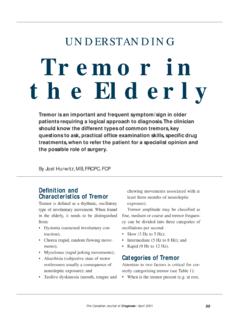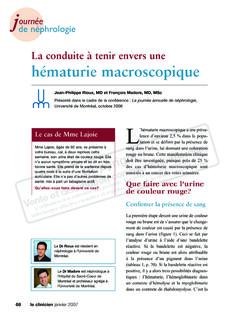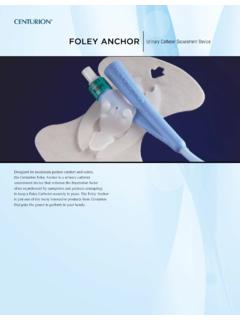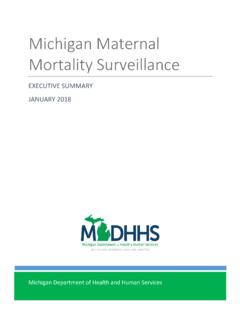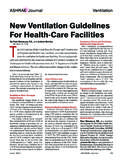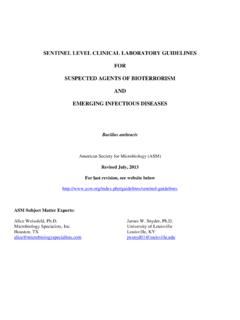Transcription of What to Do About Obstructive Urosepsis
1 Focus on CME at xxx72 The Canadian Journal of CME / December 2003 Focus on CME at Memorial University of NewfoundlandGavin Duffy, MD, FRCSCP resented at Wednesday at Noon Ask the ConsultantWhat to Do AboutObstructive UrosepsisSepsis has been described as the sys-temic inflammatory response set of definitions has beenpublished from the consensus conferenceof the American College of ChestPhysicians and the Society of CriticalCare Medicine (Table 1).2 Urosepsisimplies that the focus of infection causingsepsis arises from the urinary tract obstruction can occur at anylevel, and it can be due to congenital oracquired causes (Table 2).
2 When infec-tion becomes associated with an obstruc-tion, the situation can quickly move tourosepsis requiring urgent intervention. What is the clinicalpresentation?Given the systemic response to infectionand sepsis, there are several clinicalchanges seen (Table 3).The presentation may vary and be veryinsidious. The classic presentation offever and chills followed by hypotensionmay be seen in as little as 30% ofpatients. One of the earliest signs of sep-sis may be an increased ventilatory ratewith resultant respiratory alkalosis.
3 Theremay also be a change in mental statuswith confusion occurring. Victor s illnessVictor, 45, presented with a three-weekhistory of intermittent left side flank was diagnosed with a ureteropelvicjunction cm stone. Victor is at home awaiting a urologicreferral. He developed a fever of C,and was put on oral ciprofloxacinhydrochloride with good results. After 7 days of antibiotics, Victordeveloped weakness and a return of hisfever. He was admitted to his localhospital where he continued to worsenover a 24-hour period.
4 Despite intravenous fluids and antibiotics, hisblood pressure dropped to 90/70 mmHg. Further fluids anddopamine were administered with some response. Victor was thenairlifted to a tertiary care centre. His blood pressure on arrival was80/40 mmHg. Upon arrival, he was conversing, but was weak. Hismedical history included hypertension, diabetes of a 10-yearduration. On examination, Victor was pale, and his extremeties werecool. His abdomen was normal, with slight tenderness left flank. Laboratory results revealed: White blood cells 15x109/L Hemoglobin 132 g/L Glucose mmol/L Creatinine 243 mmol/L Blood gases on 40% oxygen-P0248 mmHg-pH Central and arterial lines were put in place in the emergencydepartment, and dopamine was continued.
5 Victor was transferredto the operating room for ureteric stenting under a neurolept anesthesia. He was admitted to the intensive care unit on pressor agents for48 hours. His blood cultures grew enterobacter agglomerans. After his discharge, Victor had delayed extracorporeal shock response may range from leuko-cytosis to leukopenia, or may remain circulatory system may show tachycar-dia > 90, increased cardiac output, anddecreased systemic vascular resistance. Thiswill clinically show as warm shock withhypotension and a febrile flushed phase may give the physician a false senseof security, as the patient may be conversingand tolerating the situation quite well.
6 Asevents progress with further losses of intravas-cular volume and decreased vascular tone, thepatient may soon convert to cold shock withlower blood pressure and cooler development is ominous and early interventionis a the disease progresses, other pulmonarychanges will occur with increased pulmonary vascu-lar resistance and ventilatory perfusion mismatch-ing. In addition, the permeability of the pulmonarycapillaries increases, leading to fluid and proteinextravasation into the pulmonary alveoli.
7 The resul-tant pulmonary edema leads to a clinical picture ofadult respiratory distress systems may become involved with pro-gressive renal and/or hepatic dysfunction. The coag-ulation system may also be disrupted with dissemi-nated intravascular coagulation occurring. Table 1 Current definitionsStateCriteriaSystemicAny two of the following:inflammatory Temperature > 38 C or < 36 Cresponse Heart rate > 90 beats per minutesyndrome Respiratory rate > 20 breaths (SIRS)per minute or PaC02< 32 mmHg White blood cells > 12 x 109/L or< 4% or >10% band formsSepsisSIRS plus clinical signs association with organsepsisdysfunction, hypoperfusion , plus hypotension despiteshockadequate fluid resuscitation, plus hypoperfusion changes, such as lactic acidosis, oliguria, or alteration in mental from: Bone R, Back RC, Cerra FB, et al.
8 Definition forsepsis and organ failure and guidelines for the use of innovativetherapies in sepsis. Chest 1992; 101(6) Canadian Journal of CME / December 2003 What are the treatments?With Obstructive Urosepsis , the immediate goal is tostabilize the patient and intervene as soon as possibleto ensure drainage of the obstructed, infected care may be as simple as fluid resuscita-tion and oxygenation prior to the urologic procedure,Table 2 Causes of urologic tract obstructionLevelTypeCommon causesRenalCongenital Ureteropelvic junction obstuction, Polycystic kidney Acquired Calculi Transitional cell tumour Retroperitoneal tumours Sloughed papillae TraumaUretericCongenitalStricture, ureterocele.
9 Ureterovesical reflux, retrocaval ureterAcquired Calculi Transitional cell carcinoma Extrinsic malignancy with compression of ureter Abcess Endometriosis Retroperitoneal fibrosis Radiation therapy Trauma PregnancyBladderCongenitalPhimosis, urethral strictureandUrethraAcquired Cancer involving bladder, prostate, urethra, or penis Bladder stones Benign prostatic hypertrophy Neurogenic bladderDr. Duffyis a clinical assistant professor, department of urology,Memorial University ofNewfoundland, St. John s, 3 Clinical changes seen in sepsisRespiratory Tachypnea Increased a-a gradient Decreased PaCO2 Alveolar edema Adult respiratory distress syndromeCardiovascular Hypotension Tachycardia Peripheral vasodilatation High cardiac outputRenal Decreased urinary output Progressive renal failureHemotologic Coagulation problems Disseminated intravascular coagulationNeurologic Confusion Decreased level of consciousnessMetabolic Increased glucoseCutaneous Vasodilatation (early) Vasoconstriction (late) Mottling, purpura (late)
10 Adapted from:Bone RC, Back RA, Cerra FB, et al: Definition for sepsisand organ failure and guidelines for the use of innovativetherapies in sepsis. Chest 1992; 101(6) JA, Lewis FR Jr, Rice C (eds.): Surgical CriticalCare. WB Saunders, Philadelphia, may require full intensive care unit admission tostabilize the patient prior to intervention. The deci-sion as to how to proceed should be balancedbetween the need for hemodynamic stability andurologic drainage. One should ensure good vascularaccess and monitoring prior to intervention, as thesepatients may deteriorate after manipulation of theinfected urologic with any resuscitation, one should strive forgood oxygenation, ventilatory support, and fluidresuscitation.

